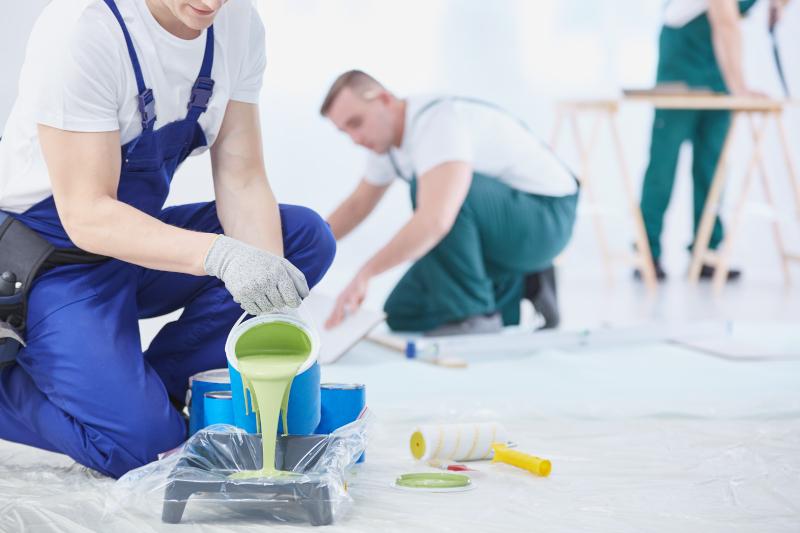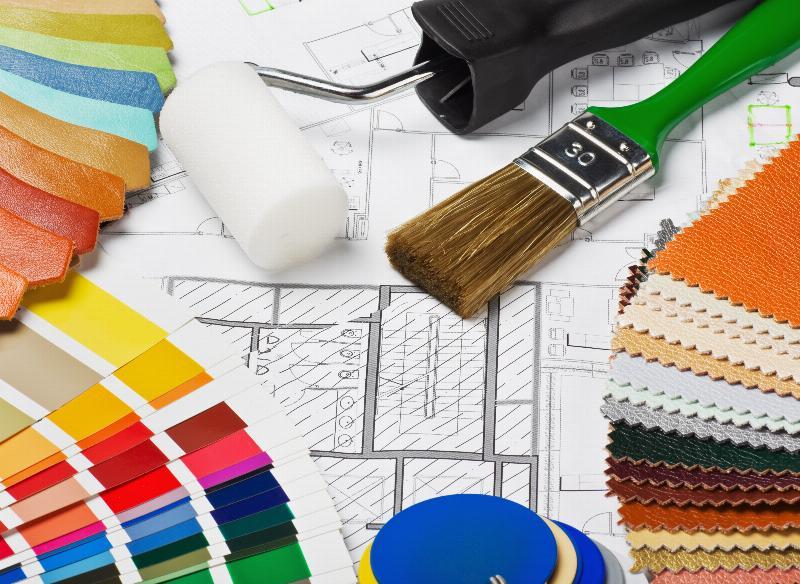Before we talk about how indoor and outdoor paint are different, it would be helpful to talk about what paint is. Paint can have a lot of different things in it, but all paint has four main components: solvents, resins, additives, and pigment.
Paint Components

Paint consists of several key components that contribute to its performance and appearance.
1. Solvent
The liquid part of the paint is the solvent. When you use latex paint, water is the solvent. Mineral spirits are used to clean up oil paint.
The solvent is what keeps the ingredients together while you spread them on your surface. When the solvent goes away, the dried paint is left behind. Oil takes longer to dry than water and has a strong scent, but it makes paint smoother and colors brighter.
2. Resins
Resins are made of epoxy or acrylic, and over time, they chip and peel off. The paint is made of resin. Varied resins provide paintings with different hardness levels, which affects their behavior. The main difference between paints for inside and outside is the resins they have.
3. Pigment
The pigment is what makes the paint the color it is. You only need a few drops of dye to make the paint any color you want, and most paint stores can help you make a color. The color of the paint doesn’t change how it works.
Pro tip takeaway: Organic pigments are used in interior paints so that extra chemicals don’t have to be added. These don’t have any strong smells and are safe to breathe in.
4. Additives
Additives provide unique features to paint and enhance its appearance and function. For instance, they may make the paint UV, water, and mildew-resistant. They also contribute to the paint’s fluidity and durability.
Exterior paint must withstand weather, debris, and temperatures. Additives help paint withstand fading, changing temperatures, and breaking. (The Family Handyman 2021)
Paint is used in a variety of ways, and interior and exterior paints are two distinct types of products. Various paints are made for different surfaces and with different properties.
All paints consist of four primary components: solvents; resin; additives; and pigments. Exterior paint may have more pigment than interior paint. They both include solvents and pigments. Interior and exterior paint differ in ingredients and resins. To tell interior from exterior paint, you must understand paint chemistry.
Exterior paint
Homeowners need to know that their house’s color is important and says a lot about their home at a glance. They should also know that the color of the outside of the car is just as important as the color of the inside. This question comes up a lot,
“Can I use paint from the inside on the outside?”
The short answer is “yes,” but you should be aware of the paint’s possible flaws because of how it is made. For example, will it hold up to the weather?
Outside you may choose brighter or neutral hues than inside. Also, keep in mind that the exterior color scheme of your home should take into account the following:
- Accent
- Trim
- Field
Accents are things like windows, doors, and shutters. Trim is made up of things like frames, fascia, gutters, and so on. Fields are like walls in that they are big and need to be painted. (Explore Wall Decor 2019)
Pro Tip takeaway: Exterior paint uses the primary color for the fields. Matching colors for trimmings and accessories.
Characteristics of Exterior Paint
- Exterior paint is subject to a variety of weather conditions. Exterior paint must protect against UV rays, mold, rain, and snow
- Exterior coatings are designed to resist mildew and fading. Due to high heat and UV radiation, they must be fade-resistant.
- External paint resins may be softer to tolerate temperature changes and moisture damage. They are expected to be adaptable. That is, they should not fracture during expansion and contraction.
- Exterior paint must be more durable and resistant to peeling and flaking.
- Exterior paint is also designed to withstand water; thus, it is waterproofed.
- Exterior paints must cure in direct sunshine.
- Exterior paint includes several chemicals including insecticides and fungicides.
- As they dry, exterior paints produce more VOC, making them unsafe for internal use.
By altering the sheen, exterior paint may be applied to many surfaces. When it rains, the outside of your home absorbs little quantities of water like a sponge. The flat paint enables water to exit without creating bubbles in the paint.
Advantage | Disadvantages |
|---|---|
Combat fades | Delicate |
Resistant to mildew | Nicks and scrapes |
It is possible to use either oil or latex paint | Gassing can last for many years |
withstands temperature fluctuations |
|
Moisture resistance |
|
Interior paint
When considering interior painting, you may have several questions.
- You may use exterior paint inside.
- You can use interior paint on the outside.
- Exterior painting over interior painting.
Interior paint should match the rest of the home. While the paint on the outside should fit in with its surroundings.
When painting the inside of a house, it is important to choose a basic color that works with the different rooms. Consider the following for ideas on what colors to use when painting the inside:
The size and number of windows
The color of the furniture and other household items
Your interior paint colors should complement:
- Dimensions of room
- Natural Light
- Furniture
- Décor
Interior painting may feature murals and ornamental art, unlike exterior painting.
Murals are scenes that are painted on all or part of a wall. The inspiration for these scenes can come from nature, art, or any other suitable source. After thinking about all these things, choose colors that fit the theme and the look you want.

Characteristics of Interior Paint
- Interior painting is more about aesthetics and décor. It’s not about upkeep, washability, and moisture resistance.
- Interior paint is designed to resist abrasion. Interior painting is more sensitive than exterior painting since it shares your space.
- Interior paints are designed to be scrubbable and stain-resistant. The formulation of interior paint makes it more resistant to physical harm.
- Interior paint isn’t affected by weather and temperature, but its resins maybe stiffer.
- Interior paint doesn’t need to be resistant to fading because it doesn’t get hot, so it doesn’t fade.
- Interior paint must be stain-resistant in order to conceal brush and roller markings.
- Interior paint should cure even without direct sunlight exposure.
- Interior paint does not need chemicals like insecticides and fungicides.
- The inner paint is washable to erase smudges and marks from young people and pets.
- Interior paint should have a low or no VOC level (volatile organic compounds). This is essential for maintaining the air quality in your house. Low or nonexistent VOCs lessen health hazards.
Interior and exterior paints are different in quality, function, and application. They can’t be used in place of each other. That is, you cannot put interior paint on outdoor surfaces or vice versa. When purchasing paint for your house, there is a need to inspect the tin.
Advantages | Disadvantages |
|---|---|
Resistant to stains | Only accepts latex paint. |
anti-scratch | Cannot tolerate temperature fluctuations. |
No off-gassing | |
Scrubbable |
|
How to Choose Which Paint to Use
There’s no good reason to use interior paint outside or exterior paint inside. They are made to be used on different surfaces and in different environments. Using paint made for the outside inside can be dangerous to your health at worst. At the very least, the resins in exterior paint make it bad for painting interior walls.
But, if you use interior paint on exterior surfaces, it won’t last as long. It’s not made to stand up to changes in temperature and UV rays. And because it’s made of hard resin, it won’t expand or contract. Instead, it will crack and peel in very hot or cold weather.
Conclusion
We hope that you can now tell the difference between interior and exterior paint.
It’s best to follow the instructions on the labels. Use indoor paint inside and exterior paint outside. Indoor paint is too hard for outside, and the harsh weather will cause it to peel and break. Outdoor paint is too soft and outgasses too much to be used inside.
Creating the perfect finish for your home’s exterior and interior is difficult. It requires a quality product.
Since the interior and exterior paint has major differences, choose the primary colors first. Homeowners should also know the size of the home, the quality, and the cost of the paint.
Are you ready to paint your home interior or exterior?
To ensure your painting is done and with the right materials, use professionals. Smart Remodeling LLC is a trustworthy firm established in Houston with an A+ rating. We are experts in residential and commercial painting. Email: sales@smartremodelingllc.com to set up a free consultation.







